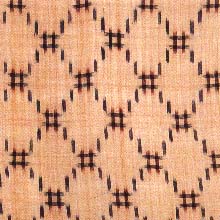Weave (p. 135 )
1. Produced in Kijoka Ogimison Kunigamigun, Okinawa Prefecture.
2. Characteristics: Fabric woven with fibers taken from "Ito Basho"(Musa liukinensis). Lighter than hemp, stiff, strong, dry and air permeable. Designs are mostly splash patterns.
3. Uses: Clothing, sashes, bedding, handbags, small items.
4. History: As the area was full of "Ito Basho," "Basho(banana plant) Fu(cloth)" was being woven in the Amami Islands and Yonaguni Island from old days and the fabric had been used for formal and everyday clothes without any discrimination of social status. It was woven already in the 13th or 14th century judging from the fact that it was listed as one of the tributes to Ming Dynasty (in China). It was the most popular fabric representing Okinawa. In 1609 the feudal government of Satsuma (Kagoshima) invaded Ryukyu(Okinawa) and ordered her a tribute to the lord, in which 3,000 rolls of "Basho Fu" was listed. Designs were mostly stripes and check then but splash patterns became the main design since 1896 when a woman started weaving the patterns. "Basho Fu" was the representative fabric of Okinawa but it was utterly unknown by outside people. Production increased in the Meiji Period as a result of the introduction of "Taka Hata"(high loom) and technical developments. However, the fabric was used only in Kagoshima Prefecture. The production was completely ceased in the years of American rule just after the WWII. An association established in 1956 has tried to produce various kinds of "Basho Fu" and made it well known. It was designated as the "Important Intangible Cultural Property" in 1974.
Dyeing Method
1. Dyes are "Ryukyu Ai"(indigo) and "Techika"(usually called "Sharinbai" or "Techiki"), both growing in Okinawa.
2. The color of the fiber of "Ito Basho" makes the background in which splash patterns are woven in indigo and light brown.
3. There are 4 kinds of "Kasuri" designs: "Tate(warp) Kasuri," "Yoko(weft) Kasuri," "Tate-Yoko Kasuri" and "Aya(twill) Naka(center)."
4. Threads are tie-dyed manually using no pattern sketch.



